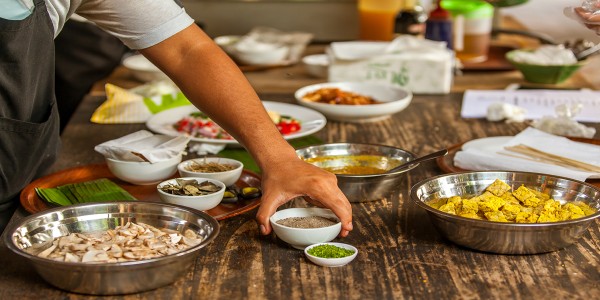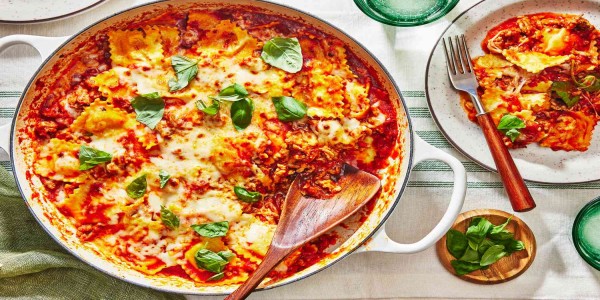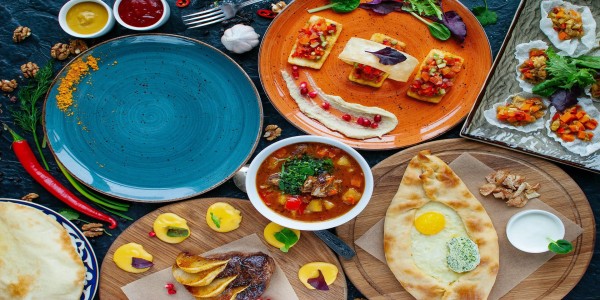Gastronomic Wonders: Exploring the Food Fairy's Pantry
Introduction
Gastronomy, the art and science of good eating, is a journey that takes us beyond the mere consumption of food. It's an exploration of flavors, cultures, and the stories behind every dish. In this blog post, we embark on a fascinating adventure into what we like to call the Food Fairy's Pantry – a realm where culinary wonders from around the world converge. Join us as we delve into exotic ingredients, savor global flavors, uncover local treasures, and appreciate the artistry that turns a meal into a masterpiece. Get ready to be inspired, as we take you on a gastronomic odyssey that transcends borders and brings the world to your plate.
Definition of Gastronomy
Gastronomy, often regarded as the art and science of good eating, encompasses a broad spectrum of culinary activities, including food preparation, presentation, and appreciation. It delves into the exploration of tastes, textures, and flavors, elevating the act of eating to a cultural and sensory experience. Gastronomy goes beyond the mere consumption of food; it involves understanding the origins of ingredients, culinary techniques, and the cultural significance of various dishes. In this blog post, we will unravel the multifaceted world of gastronomy, delving into its historical roots and its evolving role in contemporary society.
The concept of the Food Fairy's Pantry
The Food Fairy's Pantry is a whimsical yet insightful approach to gastronomy, introducing an enchanting element to the exploration of culinary delights. Picture a magical pantry where the Food Fairy curates an array of ingredients, each with its own story and significance. This concept serves as a metaphor for the diverse and rich world of gastronomy, where every ingredient plays a role in crafting a unique culinary experience. Through the Food Fairy's Pantry, we embark on a journey that transcends the mundane act of cooking and eating, embracing the magic inherent in the culinary arts.
Overview of the blog post
This blog post aims to bridge the gap between the traditional and the fantastical aspects of gastronomy. From exploring the definition and essence of gastronomy to delving into the imaginative realm of the Food Fairy's Pantry, readers will gain a deeper appreciation for the culinary world. Throughout the post, we will unravel the historical and cultural layers that contribute to the tapestry of gastronomy, inviting readers to embark on a delightful and informative journey. Join us as we unlock the secrets of the culinary arts, blending reality with a touch of magic in the Food Fairy's Pantry.
Culinary Delights from Around the World
Exotic Ingredients and Their Significance
Exploring the diverse world of culinary delights often leads us to discover exotic ingredients that add unique flavors, textures, and cultural significance to dishes. From the pungent aroma of saffron in Persian cuisine to the umami-rich kombu used in Japanese dashi, these ingredients are more than just flavor enhancers—they are cultural emblems.
Consider saffron, the world's most expensive spice. Harvested from the Crocus sativus flower, saffron not only imparts a golden hue to dishes but also carries a rich history. Used in Persian cuisine for centuries, saffron symbolizes luxury and hospitality. Its significance extends beyond the kitchen, weaving into cultural ceremonies and traditions, making it an indispensable part of Persian identity.
Similarly, the Japanese use kombu, a type of edible kelp, to create the base for their iconic dashi broth. Beyond its savory taste, kombu embodies the deep connection between Japanese culinary practices and nature. Its umami essence elevates dishes while reflecting the respect for the environment that is deeply ingrained in Japanese culture.
Exploring exotic ingredients is not just about diversifying our palates but understanding the cultural narratives and traditions that these elements carry. It's a journey that connects us to the heart of a community, fostering appreciation for the depth and diversity of global gastronomy.
Recipes that Showcase Global Flavors
Embarking on a culinary journey around the world opens up a treasure trove of recipes that showcase the rich tapestry of global flavors. From the fiery curries of India to the delicate pastries of France, each recipe tells a story rooted in history, geography, and local traditions.
Take, for instance, the classic Indian dish, Chicken Tikka Masala. Originating from the Indian subcontinent, this dish has become a global sensation, loved for its vibrant spices and tender chicken. The blend of aromatic spices like cumin, coriander, and garam masala creates a symphony of flavors that dance on the taste buds. It's a testament to the culinary prowess of Indian cuisine and its ability to captivate palates worldwide.
On the sweeter side, the French croissant is a pastry masterpiece that has transcended borders. The flaky layers and buttery richness of a perfectly baked croissant encapsulate the essence of French baking. Each bite tells a story of meticulous craftsmanship and a commitment to preserving the authenticity of a centuries-old recipe.
Exploring global recipes not only adds diversity to our dining tables but allows us to savor the world's cultural heritage. It's an invitation to embrace the culinary craftsmanship that has been perfected over generations, creating a shared experience that transcends geographical boundaries.
Cultural Influences on Gastronomy
Gastronomy is more than just the act of preparing and consuming food—it's a reflection of culture, history, and societal influences. The interplay between culinary practices and cultural traditions shapes the way we perceive and experience food.
Consider the influence of Chinese culture on the concept of family-style dining. The communal sharing of dishes reflects the importance of togetherness and harmony within Chinese families. The diversity of flavors and textures on the table symbolizes the unity of different elements, mirroring the cultural values ingrained in Chinese society.
In contrast, the meticulous and artistic presentation of Japanese kaiseki cuisine showcases the influence of Japanese aesthetics on gastronomy. Every element of a kaiseki meal is thoughtfully arranged, embodying the principles of balance, harmony, and simplicity. It's a culinary expression of the Japanese worldview, where beauty is found in the subtle details.
Exploring the cultural influences on gastronomy allows us to appreciate the deeper meaning behind the dishes we enjoy. It unveils the stories of communities, the evolution of culinary traditions, and the values that shape the way we connect with food. As we delve into the world of global cuisines, we not only savor flavors but embark on a cultural journey that broadens our understanding and appreciation of the culinary arts.
Regional Specialties and Their Unique Characteristics
Exploring the rich tapestry of regional specialties unveils a world of diverse flavors and culinary traditions. Each locality boasts its own unique dishes, shaped by centuries of cultural influences and geographic distinctions. From the savory delights of Cajun cuisine in Louisiana to the aromatic spices of Indian street food, every region tells a story through its gastronomic creations.
In the deep south of the United States, for instance, one encounters the iconic dish of gumbo, a hearty stew reflecting the amalgamation of West African, French, and Spanish culinary elements. Its rich flavors and diverse textures exemplify the cultural melting pot that defines this region. Meanwhile, in the bustling streets of Mumbai, the vibrant chaos comes alive through local street food like pav bhaji and vada pav, showcasing the bold flavors and zest that characterize Indian cuisine.
Delving into regional specialties not only tantalizes the taste buds but also opens a window to the history and traditions embedded in each bite. Whether it's the fiery kick of a Sichuan hot pot or the delicate balance of flavors in a Tuscan ribollita, regional specialties offer an immersive journey into the heart of local cultures.
Traditional Cooking Techniques Passed Down Through Generations
Behind every delectable dish lies a heritage of traditional cooking techniques, faithfully passed down through generations. These time-honored methods, often guarded family secrets, contribute to the authenticity and uniqueness of local cuisines. Whether it's the meticulous art of sushi-making in Japan or the slow-roasting methods of Argentine asado, these techniques are the threads that weave together the culinary tapestry of a region.
In Italy, the art of pasta-making is an ancient craft preserved through familial teachings. From hand-rolled orecchiette in Puglia to the delicate strands of tagliatelle in Bologna, the intricate skills involved showcase the commitment to preserving culinary heritage. Similarly, the tandoor cooking technique in India imparts a distinct smokiness to dishes like naan and tandoori chicken, embodying a culinary legacy that spans centuries.
Understanding these traditional cooking techniques not only enhances the appreciation of a dish but also serves as a testament to the resilience of culinary traditions in the face of modernization. These techniques bridge the gap between the past and the present, allowing us to savor the flavors of history on our plates.
The Role of Local Ingredients in Creating Distinct Flavors
Local ingredients act as the bedrock of distinct flavors, grounding regional cuisines in the essence of their surroundings. From the fresh seafood of coastal regions to the hearty grains of mountainous terrains, the geographical diversity of ingredients shapes the character of local dishes.
In the Mediterranean, the use of olive oil, tomatoes, and aromatic herbs defines the light and refreshing nature of dishes like Greek salad and Italian bruschetta. On the other hand, the bold and robust flavors of Mexican cuisine find their roots in ingredients like chili peppers, corn, and avocado. Each bite tells a story of the land, climate, and culture that nurtured these ingredients.
Exploring the role of local ingredients not only highlights the unique flavors they contribute but also emphasizes the importance of sustainable and seasonal eating. By celebrating and preserving these local treasures, we not only savor the authenticity of a cuisine but also contribute to the preservation of ecosystems and agricultural practices that sustain communities.
Culinary Aesthetics and the Importance of Visual Appeal
In the realm of gastronomy, the presentation of a dish is an art form that goes beyond mere sustenance. Culinary aesthetics, the visual appeal of a dish, play a pivotal role in elevating the overall dining experience. A well-presented plate not only stimulates the taste buds but also engages other senses, creating a multisensory journey for the diner.
Chefs often leverage principles of color theory, symmetry, and creative plating techniques to craft visually stunning masterpieces. The vibrant hues of fresh vegetables, the intricate arrangement of components, and the use of negative space on the plate all contribute to the visual allure of a dish. Beyond the dining table, social media platforms have further amplified the importance of culinary aesthetics, with users increasingly seeking visually pleasing food experiences to share with their followers.
Instagram-Worthy Dishes and Their Popularity
The rise of social media, particularly Instagram, has significantly influenced the way food is presented and consumed. The era of "Instagram-worthy" dishes has emerged, where the visual appeal of a meal is just as crucial as its taste. Restaurants and chefs now design dishes with photogenic qualities in mind, understanding that a visually striking presentation can lead to increased online visibility and customer engagement.
From meticulously crafted desserts to intricately plated entrees, Instagram-worthy dishes have become a phenomenon, enticing food enthusiasts to share their dining experiences online. This trend has not only reshaped the restaurant industry but has also inspired home cooks to experiment with creative plating techniques to make their meals visually captivating.
Balancing Taste and Presentation in Gastronomy
While visual appeal is undeniably important, chefs must strike a delicate balance between taste and presentation. The ultimate goal is to create a harmonious marriage between the flavors on the plate and its visual allure. A visually stunning dish should not compromise on taste, as the true essence of gastronomy lies in delivering a delightful sensory experience.
In the pursuit of culinary excellence, chefs experiment with various textures, flavors, and cooking techniques to ensure that each component complements the others. The challenge lies in achieving a perfect equilibrium where the dish not only looks appealing but also delivers an exceptional taste experience. This delicate balance is what distinguishes culinary artistry from mere food preparation, creating memorable dining moments that linger in the minds of those fortunate enough to savor them.
Evolution of Culinary Techniques Over Time
The journey through food history unveils a fascinating evolution of culinary techniques that have shaped the way we prepare and enjoy our meals today. In ancient times, humans relied on basic methods like roasting, boiling, and fermenting to transform raw ingredients into edible dishes. As societies progressed, culinary techniques became more sophisticated.
The Renaissance marked a significant turning point, with the emergence of elaborate cooking methods and the introduction of spices from distant lands. During the Industrial Revolution, technological advancements revolutionized food preparation, introducing tools like the stove and the refrigerator. Fast forward to the modern era, and we find ourselves in a culinary landscape influenced by molecular gastronomy, sous-vide cooking, and other avant-garde techniques.
Exploring the evolution of culinary techniques not only showcases human innovation but also reflects the socio-economic and cultural changes that have shaped our culinary heritage. Today's chefs draw inspiration from centuries-old methods while incorporating cutting-edge technologies to create a diverse and dynamic culinary experience.
Historical Anecdotes About Famous Dishes
Behind every delicious dish lies a rich tapestry of historical anecdotes that add flavor to its origin story. Take, for instance, the classic Beef Wellington. Legend has it that the dish was named in honor of the Duke of Wellington, who defeated Napoleon at the Battle of Waterloo. Its intricate layers of beef, mushroom duxelles, and puff pastry are said to represent the Duke's impeccable military strategy.
Another iconic dish with a captivating history is Caesar Salad. Contrary to popular belief, it wasn't born in ancient Rome but in Tijuana, Mexico. Created by Caesar Cardini, an Italian-American restaurateur, the salad became an instant hit during the Prohibition era when Hollywood celebrities flocked to his establishment.
Unraveling the historical narratives behind famous dishes not only adds an intriguing dimension to our culinary knowledge but also connects us to the cultural contexts in which these recipes were born.
How Food Shapes Cultural Identity
Food is not just sustenance; it is a profound reflection of cultural identity. The culinary traditions of a community encapsulate its history, geography, and social practices. The spices used, the cooking methods employed, and the rituals associated with meals all contribute to shaping a distinct cultural identity.
For example, the traditional Japanese tea ceremony is not just about serving tea; it is a symbolic act that embodies harmony, respect, purity, and tranquility. Similarly, the rich and varied tapestry of Indian cuisine mirrors the country's diverse landscapes and cultural amalgamation.
Food becomes a cultural ambassador, transcending borders and fostering understanding between communities. Exploring the role of food in shaping cultural identity allows us to appreciate the diversity that makes our global culinary heritage so rich and meaningful.
Accessible Ingredients for Home Cooks
Transforming your kitchen into a haven of gastronomic delights begins with the right ingredients. Fortunately, the Food Fairy's Pantry is not an elusive place; it can be your own kitchen cabinet. Home cooks can easily access a plethora of ingredients that add depth and flavor to their dishes. Staples like olive oil, garlic, herbs, and spices form the foundation, enhancing the taste of any dish. For a touch of luxury, consider incorporating truffle oil or saffron threads, easily available at local grocery stores or online markets.
Opting for seasonal and locally sourced produce not only supports the community but also guarantees freshness. Explore farmer's markets or join a local CSA (Community Supported Agriculture) to discover a variety of fruits and vegetables that elevate your dishes. Don't forget the power of pantry staples like canned tomatoes, beans, and quality broths, ensuring you're always ready to whip up a delightful culinary creation.
Easy-to-Follow Recipes for a Taste of Gastronomic Wonders
Embarking on a journey into the realm of DIY Gastronomy requires reliable and straightforward recipes. Fear not, as we've curated a collection of easy-to-follow recipes that promise a taste of gastronomic wonders without overwhelming your culinary skills. From simple yet delectable pasta dishes to succulent roasted meats with a twist, these recipes are designed to inspire and excite your taste buds.
Experiment with flavors by trying out fusion recipes that blend diverse culinary traditions, providing a unique and delightful experience. Our recipe collection caters to various dietary preferences, ensuring that everyone can savor the magic of homemade gastronomy. Detailed step-by-step instructions and accompanying visuals make the cooking process enjoyable and accessible, even for novice chefs.
Tips for Experimenting with Flavors and Techniques
The heart of DIY Gastronomy lies in experimentation, and we've got you covered with valuable tips to unleash your creativity. Dive into the world of flavor pairing by combining unexpected ingredients to create harmonious and memorable taste profiles. Explore different cooking techniques, from sous-vide to fermentation, to add layers of complexity to your dishes.
Don't shy away from tweaking recipes to suit your palate. Personalization is key, and our tips empower you to confidently play with flavors, textures, and presentation. Embrace the joy of culinary exploration by incorporating international cooking techniques into your repertoire, elevating your home-cooked meals to restaurant-worthy creations.
In the Food Fairy's Pantry, every home cook can find the tools and inspiration needed to turn ordinary meals into extraordinary experiences. With accessible ingredients, easy-to-follow recipes, and tips for experimentation, your kitchen is poised to become the epicenter of gastronomic delight.

Recap of the Culinary Journey
As we conclude this delectable expedition through the world of flavors and culinary wonders, it's time to savor the memories we've created together. From the rich spices of Indian cuisine to the delicate artistry of French pastries, our journey has been a tapestry of diverse tastes and cultural influences. We've explored the kitchens of various nations, each dish telling a unique story and inviting us to indulge in a symphony of aromas and textures.
Throughout this culinary voyage, we've learned that food is not just sustenance but a form of art that connects people across borders. The recipes shared have not only tantalized our taste buds but have also opened a window into the heart of different cultures. As we reflect on the myriad flavors sampled, let's carry these experiences forward, fostering a deeper appreciation for the rich tapestry of global cuisine.
Encouragement to Explore and Appreciate Diverse Cuisines
Our culinary journey has only scratched the surface of the vast world of food waiting to be explored. As we bid adieu to this particular adventure, let it be an encouragement to embark on your own gastronomic escapades. Venture beyond the familiar and embrace the unknown, for it is in the exploration of diverse cuisines that we truly broaden our culinary horizons.
Challenge yourself to try new ingredients, experiment with exotic recipes, and delve into the stories behind each dish. Whether you're a seasoned home cook or a novice in the kitchen, the world of food offers endless possibilities for discovery. Celebrate the diversity that makes our global pantry so rich, and let your taste buds be your guide on a journey of continual exploration.
Inviting Readers to Share Their Own Gastronomic Adventures
As we wrap up this flavorful expedition, the kitchen door remains wide open for you to step in and share your own gastronomic adventures. Have you recently discovered a hidden gem of a recipe, or perhaps stumbled upon a local eatery that left a lasting impression? We invite you, our fellow culinary enthusiasts, to become part of this ongoing conversation.
Drop a comment below, sharing your favorite culinary experiences, treasured recipes, or even the challenges you've faced in the kitchen. Let's turn this conclusion into a new beginning, creating a community where the love for food knows no bounds. Your stories and insights add layers to the ever-expanding tapestry of global gastronomy, making our collective journey richer and more vibrant. So, share away, and let the culinary dialogue continue!
FAQs
Q. How does the Food Fairy define "wholesome" in terms of eating?
A. Wholesome, for the Food Fairy, means consuming a well-balanced diet rich in nutrients, emphasizing fresh and unprocessed foods, and enjoying a variety of flavors to support overall health and well-being.
Q. Can children enjoy the Food Fairy's approach to healthy eating?
A. Absolutely! The Food Fairy encourages introducing children to a variety of wholesome foods from an early age. By making meals colorful and engaging, children can develop a positive relationship with healthy eating.
Q. Are the recipes suitable for individuals with dietary restrictions?
A. Yes, the Food Fairy's recipes are adaptable. Whether you have dietary restrictions or preferences, the article provides insights into modifying recipes to suit various needs.
Q. How can I incorporate the Food Fairy's principles into my busy lifestyle?
A. The Food Fairy recommends simple steps like meal prepping, choosing quick and nutritious recipes, and being mindful of food choices. Small changes can lead to a more wholesome and sustainable lifestyle.
Q. Is the Food Fairy's approach to healthy eating suitable for weight management?
A. Absolutely! The Food Fairy's approach emphasizes a balanced and nutritious diet, supporting overall health, which can contribute to weight management in a sustainable way.
Q. Does the Food Fairy offer meal plans or personalized guidance?
A. While the article provides a comprehensive guide, personalized guidance can be sought from nutritionists or dietitians. The Food Fairy encourages individuals to find a plan that suits their unique needs.
Conclusion
As our culinary journey through the Food Fairy's Pantry comes to a close, we find ourselves enriched with a newfound appreciation for the diverse and delectable world of gastronomy. From the tantalizing tastes of exotic ingredients to the heartwarming familiarity of local cuisines, we've explored the rich tapestry that makes up our global food culture. The artistry of presentation, the depth of historical flavors, and the joy of recreating these wonders in our own kitchens have all played a part in this gastronomic adventure.
As we conclude, we invite you to continue exploring, tasting, and sharing your own gastronomic wonders. Whether you're a seasoned chef or an enthusiastic home cook, there's always something new to discover in the vast and ever-evolving world of food. So, let your taste buds be your guide, and may the Food Fairy's Pantry continue to inspire your culinary escapades. Cheers to the endless possibilities that await in the realm of delicious delights!









